HEYDRICH’S DEATH UNLEASHES HORRIFIC REPRISALS
Berlin, Germany · June 9, 1942
On this date in 1942, with the full leadership of the Third Reich in attendance, Nazi “martyr” Reinhard Heydrich was eulogized in one of the most elaborate funerals ever staged in Berlin. (Heydrich had been added by Adolf Hitler to the “honorary list of the Fallen of the Nazi Movement.”) The ceremony in Hitler’s New Reich Chancellery was stage-managed and filmed by Joseph Goebbels, Nazi Minister of Public Enlightenment and Propaganda. Two weeks earlier, in an British-inspired assassination plot codenamed Operation Anthropoid, two Czech resistance fighters, Warrant Officer Jozef Gabčík and Staff Sergeant Jan Kubiš, had succeeded in mortally wounding the 38‑year-old Acting Reichsprotektor (Reich Protector) of Bohemia and Moravia, part of dismembered Czechoslovakia (today an area lying within the Czech Republic, or Czechia [short‑form name]). Both men had received awards for military valour, Gabčík the French Croix de Guerre for action during the Battle of France (May 10–June 25, 1940), Kubiš the Czech War Cross.
The day following the funeral one of the most infamous episodes of Nazi retribution occurred in a Czech hamlet 48 miles northwest of the capital, Prague. Prodded by Hitler, the Nazis chose to take revenge on Lidice (population just over 500) because the villagers were suspected of harboring local resistance fighters, and two families who lived there had sons serving with Czech exile forces in England. So in the predawn hours of June 10 ten truckloads of German Army field police and SD (Sicherheitsdienst, the Nazi Party’s intelligence agency) surrounded Lidice and nearby Ležáky, where a radio transmitter Gabčík and Kubiš had used was found. In Ležáky all 33 adult inhabitants were killed. In Lidice every man and boy over 16 years—192 in all—was stood against a barn wall and shot or burned alive in a nearby barn (26) to speed up the killing. Some 200 Lidice women were deported to the notorious women’s Ravensbrueck concentration camp in Northern Germany, where most died. Ninety young children were poisoned by exhaust fumes in specially adapted vehicles in the Chełmno death camp in Poland. A small number, having been “racially separated” from the rest, were delivered to SS families because they were viewed as fit for “Germanization.”
Meanwhile, the SS (Schutzstaffel, the Nazi Party’s so-called “protection squad”) and the Gestapo (Geheime Staatspolizei, or Secret State Police) hunted down and murdered Czech resistance members and anyone suspected of being involved in or approving of Heydrich’s death, nearly wiping out the Czech underground. Excluding those murdered in Lidice and Ležáky, 3,188 Czechs were arrested and of those, 1,327 were sentenced to death. Newspapers and loudspeakers broadcast the names of people who had been executed each day. In addition, 3,000 Jews were deported from the Czech ghetto at Theresienstadt (present-day Terezín) and sent to their deaths. In Berlin, 500 Jews were arrested, with 152 executed as a reprisal on the day Heydrich died, June 4. In a diary entry two days earlier Goebbels wrote: “As a result of the Heydrich assassination, a whole range of incriminated Jews have been shot in Sachsenhausen,” the principal SS concentration camp for the Berlin area. (Quoted in Gerwarth; see below.) As for Lidice itself, it was completely leveled, its graveyard disinterred, and grain scattered over the spot where the village had stood. Even the name Lidice (German, Liditz) was removed from German maps.
![]()
Reinhard Heydrich’s Assassination and the Blood Sacrifice of Lidice
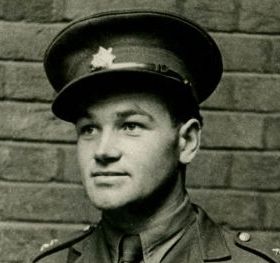 | 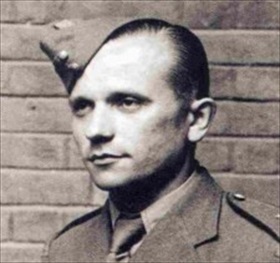 |
Left: Staff Sergeant Jan Kubiš (1913–1942), one of nine Czechoslovak British-trained paratroopers dropped into Czechoslovakia as part of Operation Anthropoid, the daring and successful assassination of SS-Obergruppenfuehrer Reinhard Heydrich (1904–1942), Reich Protector of Bohemia and Moravia. On June 18, 1942, two weeks after Heydrich’s death, Kubiš was wounded in a six-hour gun battle with German troops in the crypt of the Church of Saints Cyril and Methodius in Prague. He died shortly after being taken to a hospital.
![]()
Right: Warrant Officer Jozef Gabčík (1912–1942) was a Slovak soldier in Czechoslovakia’s army-in-exile in England. Using an antitank grenade, Kubiš and Gabčík waylaid Heydrich on May 27, 1942, as he commuted in his Mercedes-Benz convertible between his home and office in Prague Castle. Gabčík, seriously wounded by a grenade in the same church firefight, committed suicide alongside other Czech and Slovak freedom fighters to avoid capture. On September 1, 1942, the spiritual leader of Prague’s Orthodox community and three priests who had sheltered Heydrich’s assassins were sentenced to death and killed three days later. Over the next few weeks, 236 more individuals implicated in Operation Anthropoid were taken to Mauthausen concentration camp in Austria and murdered.
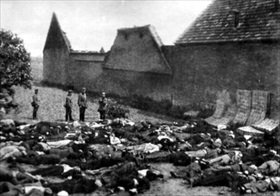 | 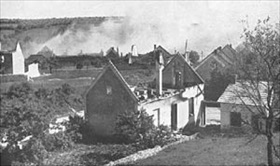 |
Left: Men massacred in the sleepy Czech mining village of Lidice, June 10, 1942. Taken by a German soldier, this photograph was initially kept by the Gestapo. Hours earlier all male villagers were rounded up and taken to a farm on the edge of the village that belonged to the Horák family, whose son Josef served in the Czechoslovak army-in-exile in Britain. Mattresses were taken from neighboring houses and placed against the Horák barn. There 192 Lidice residents were executed, ten at a time, in cold blood. The massacre came to symbolize German occupation of Czechoslovakia.
![]()
Right: The Lidice tragedy was filmed by those who actually carried out the brutal crime. German authorities gleefully reported Lidice’s destruction in newsreels and propaganda speeches. To the Allies, Lidice became the symbol of the German policy of Schrecklichkeit (terror). The film was entered into evidence at the postwar Nuremberg trials of Nazi German leaders in 1945–1946.
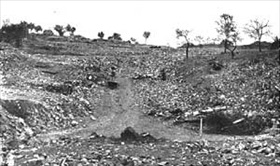 | 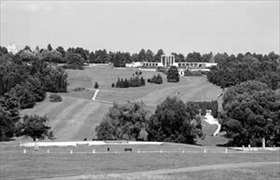 |
Left: Having rid the village of its inhabitants, the Nazis destroyed the village itself, first setting the houses on fire and then razing them to the ground with plastic explosives. They didn’t just stop there but proceeded to destroy the village church and cemetery. After removing 84,000 square yards of rubble, they leveled the ruins, plowed them over, and planted grain. In 1943 all that remained of Lidice was an empty field cordoned off by signs forbidding entry
![]()
Right: Instead of consigning Lidice to eternal oblivion, Lidice came to symbolize the German occupation of Czechoslovakia. The New York Times newspaper asked its readers how the atrocity should be remembered. Around the world, in the U.S., Mexico, Panama, Peru, and Brazil for instance, towns adopted the name Lidice in memory of the vanished village, and many women born at that time were named Lidice. Overlooking the site of the old village of Lidice today is a museum and a small exhibition hall, and in front of the museum is a bronze memorial to the children killed in the Chełmno death camp in Poland. After the war ended, only 153 women and 17 children returned to Lidice.
Lidice: The Town Hitler Ordered to “Die Forever”
![]()

 History buffs, there is good news! The Daily Chronicles of World War II is now available as an ebook for $4.99 on Amazon.com. Containing a year’s worth of dated entries from this website, the ebook brings the story of this tumultuous era to life in a compelling, authoritative, and succinct manner. Featuring inventive navigation aids, the ebook enables readers to instantly move forward or backward by month and date to different dated entries. Simple and elegant! Click
History buffs, there is good news! The Daily Chronicles of World War II is now available as an ebook for $4.99 on Amazon.com. Containing a year’s worth of dated entries from this website, the ebook brings the story of this tumultuous era to life in a compelling, authoritative, and succinct manner. Featuring inventive navigation aids, the ebook enables readers to instantly move forward or backward by month and date to different dated entries. Simple and elegant! Click 











